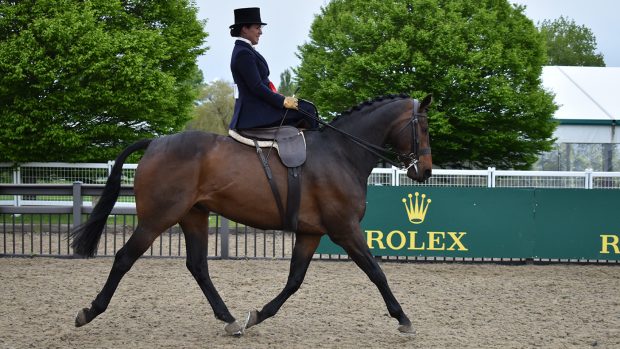Leading show horse producer Jayne Ross gives her advice on how to get the best out of a horse when riding sideways
Jayne has won the supreme titles at Horse of the Year Show (HOYS) and Royal International (RIHS) countless times. In 2018, she won the supreme HOYS title aboard the ladies’ show horse winner, Time 2 Reflect. She has also evented at advanced level and represented Britain in combined training, as well as training 48 point-to-point winners. Here she shares her advice on how to ride side-saddle.
Training the stars
My first HOYS win on a side-saddle horse was in 1994 riding Norman Swallow’s Sudden Flight. He was also successful as a lightweight hunter and was a fantastic ride astride. He was level, so I knew he would carry a side-saddle. He took to it immediately and was perfect.
As much as you can teach the right way to ride side saddle, the rider has to feel secure and at ease. However, there are certain key rules to follow on how to ride in order to not disturb the horse’s centre of balance and equilibrium.
How to ride side-saddle
1. Before you begin, it’s important to seek expert guidance on the fitting of a side-saddle as this is not as straightforward as you might think. Horses react in different ways to saddles that might be pinching across their withers or sitting unlevel on their backs.
2. The most important thing is harmony between horse and rider in all paces. The least amount of rider influence is likely to enhance that. It’s important that you are sitting straight in the saddle. Your hips must be level with your horse’s ears — as they would be astride — and it’s imperative to keep your right shoulder up and back.
3. One major problem riders tend to have is a collapsing left hip, which consequently means you’re putting more weight on the left side, forcing your horse to fall in. Ensure you stay sitting straight in the saddle to help your horse stay straight and balanced.
4. The stirrup should not be so short that it makes you feel jammed under the lower pommel. You should be able to put a flat hand between it and the top of your leg. This allows you to keep your weight down into the stirrup, too.
5. One of the tricks I was taught when learning is to feel as if you’re trying to put your right heel against your left shin. This makes you point the toes on your right foot down and draws you into the leaping head (top pommel), which helps you feel more secure.
Things to consider
- As children, we were taught to hold our right hand straight down by our sides and the left hand up in a normal position, but I feel this makes you drop your right shoulder too much. I have always felt it easier to keep my hands up and level in front of me.
- Make sure your whip — which is always carried in your right hand and is in effect used as your right leg — is of a suitable length to use without you moving your hands. The noise of tapping the saddle is usually enough to encourage your horse forward.
- Allow your horse to absorb your weight. You should sit tall — but softly — in the saddle. The more level and forward going your horse is, the more likely you are to be able to keep him straight.
You might also be interested in:

Introducing a horse to side-saddle with Royal Windsor ladies show horse winner Jayne Ross
Find out what showing star Jayne Ross thought of the competition in the ladies show horse (side-saddle) class and learn

Subscribe to Horse & Hound magazine today – and enjoy unlimited website access all year round
Horse & Hound magazine, out every Thursday, is packed with all the latest news and reports, as well as interviews, specials, nostalgia, vet and training advice. Find how you can enjoy the magazine delivered to your door every week, plus options to upgrade your subscription to access our online service that brings you breaking news and reports as well as other benefits.



